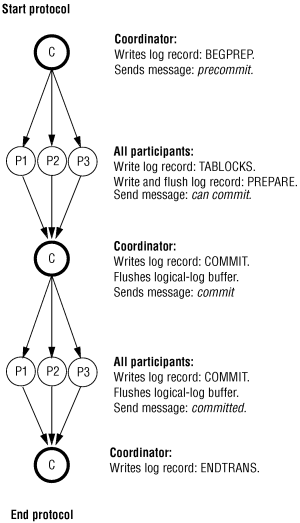Logical-log records when the transaction commits

Some of the logical-log records must be flushed from the logical-log buffer immediately; for others, flushing is not critical.
The coordinator's commit-work record (COMMIT record) contains all information required to initiate the two-phase commit protocol. It also serves as the starting point for automatic recovery in the event of a failure on the coordinator's host computer. Because this record is critical to recovery, it is not allowed to remain in the logical-log buffer. The coordinator must immediately flush the COMMIT logical-log record.
The participants in the preceding figure must immediately flush both the PREPARE and the COMMIT logical-log records. Flushing the PREPARE record ensures that, if the participant's host computer fails, fast recovery is able to determine that this participant is part of a global transaction. As part of recovery, the participant might query the coordinator to learn the final disposition of this transaction.
Flushing the participant's COMMIT record ensures that, if the participant's host computer fails, the participant has a record of what action it took regarding the transaction. To understand why this information is crucial, consider the situation in which a participant crashes after the PREPARE record is written but before the COMMIT record flushes. After fast recovery, the PREPARE record is restored, but the COMMIT record is lost (because it was in the logical-log buffer at the time of the failure). The existence of the PREPARE record would initiate a query to the coordinator about the transaction. However, the coordinator would know nothing of the transaction, because it ended the transaction after it received the participant's acknowledgment that the commit occurred. In this situation, the participant would interpret the lack of information as a final direction to roll back the transaction. The two-phase commit protocol requires the participant's COMMIT record to be flushed immediately to prevent this kind of misunderstanding.